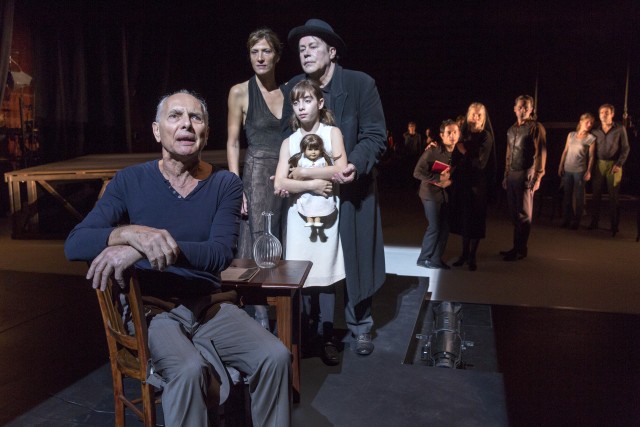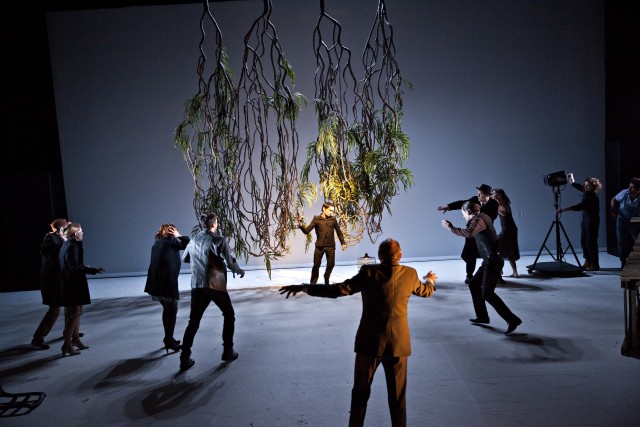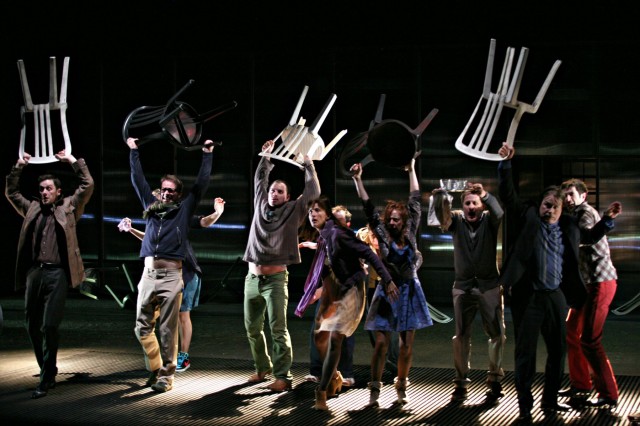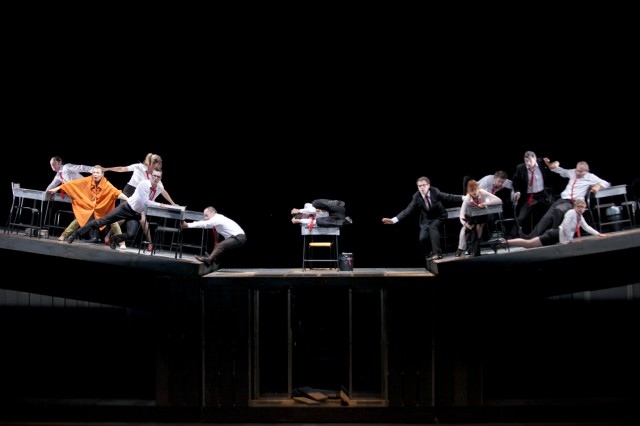
Théâtre de la Ville is back at BAM with an awe-inspiring production of Luigi Pirandello’s absurdist masterpiece (photo by Richard Termine)
2014 NEXT WAVE FESTIVAL
Brooklyn Academy of Music
BAM Harvey Theater
651 Fulton St. between Ashland & Rockwell Pl.
October 29 – November 2, $20-$75
718-636-4100
www.bam.org
www.theatredelaville-paris.com
As audience members begin filing into the BAM Harvey to see Théâtre de la Ville’s awe-inspiring production of Luigi Pirandello’s absurdist classic Six Characters in Search of an Author, there is already a man onstage, suspended from above, painting a trompe-l’oeil blue sky backdrop; he is soon joined by a young woman who sits at a sewing machine, making costumes while quietly singing “O sole mio.” These two actions subtly announce that what we are about to see is artifice — what Pirandello called “the theater of the theater” — albeit multilayered artifice of the very highest order. For the next two hours, we are treated to a rapturous display of intensely clever stagecraft, filled with self-referential jokes about the theater, intellectual discussions of illusion vs. reality, and a search for nothing less than the very meaning of existence. A dictatorial director (Alain Libolt) is preparing his cast and crew to rehearse the second act of Pirandello’s The Rules of the Game when six mysterious people, all dressed in black, suddenly appear, claiming to be fictional characters abandoned by their author and now seeking a place where they can tell their story, which is the whole reason for their being. The director, the stage manager (Gérald Maillet), the actors (Charles-Roger Bour, Sandra Faure, Olivier Le Borgne, and Gaëlle Guillou), the carpenter (Pascal Vuillemot), and the assistant (Jauris Casanova) are at first dubious of the six strangers, but soon the father (Hugues Quester) convinces them to hear them out, so they delve into a soap-opera-like tale of faded love, mourning, incest, sibling rivalry, and horrific tragedy also involving the sexy stepdaughter (Valérie Dashwood), the grieving mother (Sarah Karbasnikoff), the estranged son (Stéphane Krähenbühl), the awkward teenager (Walter N’Guyen), and the adorable little girl (Sierra Blanco).

Glorious production seeks to lift the veil on some of the many mysteries of the theater (photo by Richard Termine)
No one onstage has a name, save for the surprise arrival of Madame Pace (Céline Carrère); everyone else represents a stock character determined to experience their individual purpose, their raison d’être, whether in the play, the play-within-a-play, or the play-within-a-play-within-a-play. There are no rules to this sly game directed by Théâtre de la Ville head Emmanuel Demarcy-Mota, who was last at BAM in October 2012 with another delightful absurdist classic, Eugène Ionesco’s Rhinocéros. This is his third time staging Six Characters in Search of an Author, and he clearly knows his way around this existential journey of life as theater, and theater as life, expertly translated and adapted by François Regnault. The cast is uniformly excellent, led by Libolt, Dashwood, and Quester, who won the Critics’ Award for Best Actor for Théâtre de la Ville’s original 2001 production. Throughout the play, which is itself, of course, set in a theater, various characters look out at the seats, which to them are empty but to the actors playing them are filled with onlookers, furthering the self-referential nature of the show and the relationships between actor and audience, creator and creation. The director even references the subtitles at one point, reminding everyone that this is, at its most basic, an Italian play put on by a French company in an American city. Every moment is pure genius, a palimpsest of metas that keep piling on in glorious ways, a celebration of just what the theater can do and be, from behind the scenes to the last row of the balcony.


